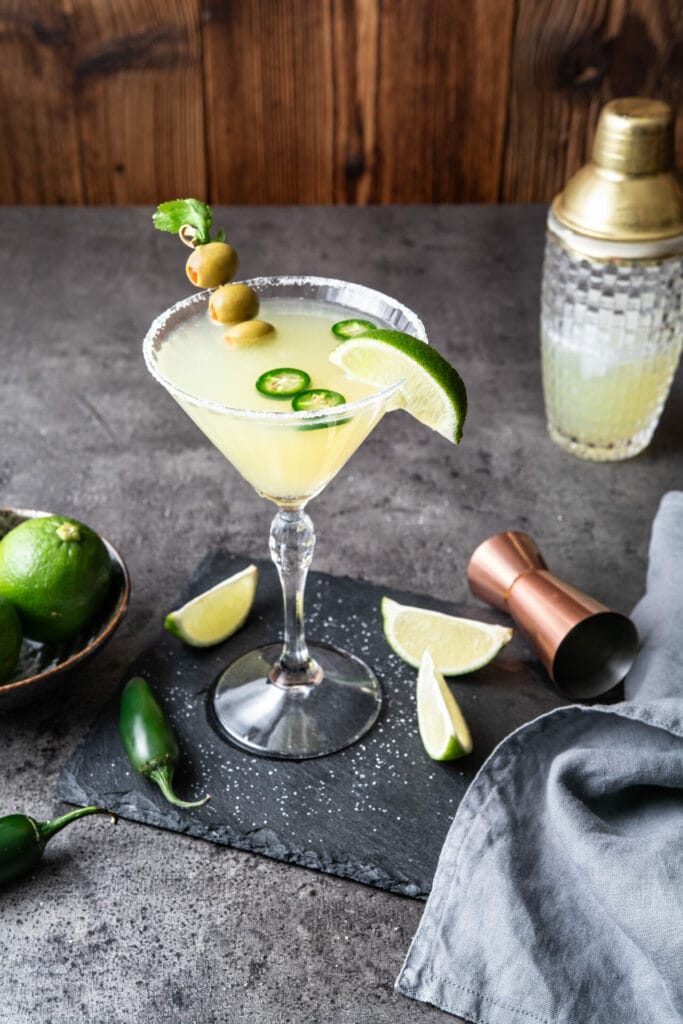The ultimate, classic cocktail gets imbued with Southern flair to make the Mexican Martini (a.k.a. Texas Martini)—a complex flavor profile of tequila, Cointreau, citrus juices, and brine.

There was a time not long ago when martini bars were all the rage. Twentysomethings in clip-on ties and the dresses they wore to prom would sit nervously at high tables, eyeing the menu of drinks foreign to them. Inevitably, they would order something with a naughty name or the prefix “choco.” Martini bars are still around, though I don’t think are as ubiquitous as they once were. They stick to the classics, including today’s special: the Mexican Martini.
So the story goes, it was invented by a bartender in Austin, Texas. She was visiting a bar in a small town across the Mexican border and was entranced by the way they made their margaritas. In particular, she liked that they served them in martini glasses. The bartender made note of what she had learned and, upon returning to work, took that drink, added an olive garnish and brine to replicate a dirty martini, and christened it the Mexican (or Texas) Martini.
So the name is a bit of a misnomer—it’s not really a Mexican drink nor is it, strictly speaking, a martini. It’s about as Tex-Mex as you can get though, with elements from both drinks and both cultures. That means it’s perfect for Cinco de Mayo… or any day at all!
What are the Different Kinds of Tequila?
Tequila, which is derived from the fermented juice of the blue agave plant, has many varieties. One of the most common is Blanco (silver or white). It’s bottled shortly after it’s distilled (so, isn’t allowed to age) and has a strong agave taste with a hint of pepper. Joven (gold or young) tequila is a mix of Blanco and aged tequilas, sometimes with the addition of caramel and sugar. Reposado (rested) is a very popular higher-end tequila that is aged in barrels and is given a smooth vanilla, caramel flavor. Añejo (aged) is kept in barrels longer than the reposado and so bears many of the same characteristics but… more so. Recently introduced is Extra Añejo, which is rich and dark, thanks to its extended time spent in the barrels.
Ingredients
- 2 oz. tequila silver or reposado
- 1 oz. Cointreau or any orange liqueur
- 1.5 oz. freshly squeezed lime juice
- 1.5 oz. freshly squeezed orange juice
- 0.5 oz. olive brine
- splash of agave nectar or simple syrup
- ice cubes
- lime wheel and 2-3 skewered olives for garnish
Instructions
- In a cocktail shaker, combine the tequila, Cointreau, lime juice, orange juice, olive brine, and agave nectar/simple syrup.

- Fill the shaker with ice, secure the lid, and shake until the exterior becomes frosty.
- Strain the cocktail into a martini glass rimmed with salt

- Float a lime wheel on top and hook a skewer of olives onto the rim of the glass.

Nutrition
Tips & Tricks to Making the Perfect Mexican Martini
- Use fresh lime juice and orange juice and forgo the convenience of the store-bought stuff, which contains unwanted ingredients and, to me, tastes synthetic.
- Choose a good tequila, preferably a Reposado, which means that it is a tequila that has been aged in oak barrels. As a result, its smooth flavor profile will feature hints of vanilla, caramel, and spice.
- Use martini olives, which are usually larger and stuffed with pimiento (sweet red pepper). They have a distinct taste compared to other olives, thanks to the brine they’re preserved in.
- If you don’t have Cointreau, reach for Grand Marnier (another orange liqueur). If neither is available, you can use triple sec, though the sophistication in taste will be lost.
- To create the salted rim, run a lime wedge around the rim of the glass. Spread some kosher salt out on a small plate then, with the glass upside down, dip it into the salt. Spin the glass back and forth to ensure a good amount of salt adheres to the glass.

FAQs

Mexican Martini Variations
Spicy Mexican Martini: Add some muddled jalapeno peppers and hot sauce.
Pineapple Mexican Martini: Add pineapple juice or even muddled pineapple.
Mango Mexican Martini: Add mango juice or puree.
Strawberry Mexican Martini: Add strawberry puree and garnish with a strawberry slice.






Leave a Comment